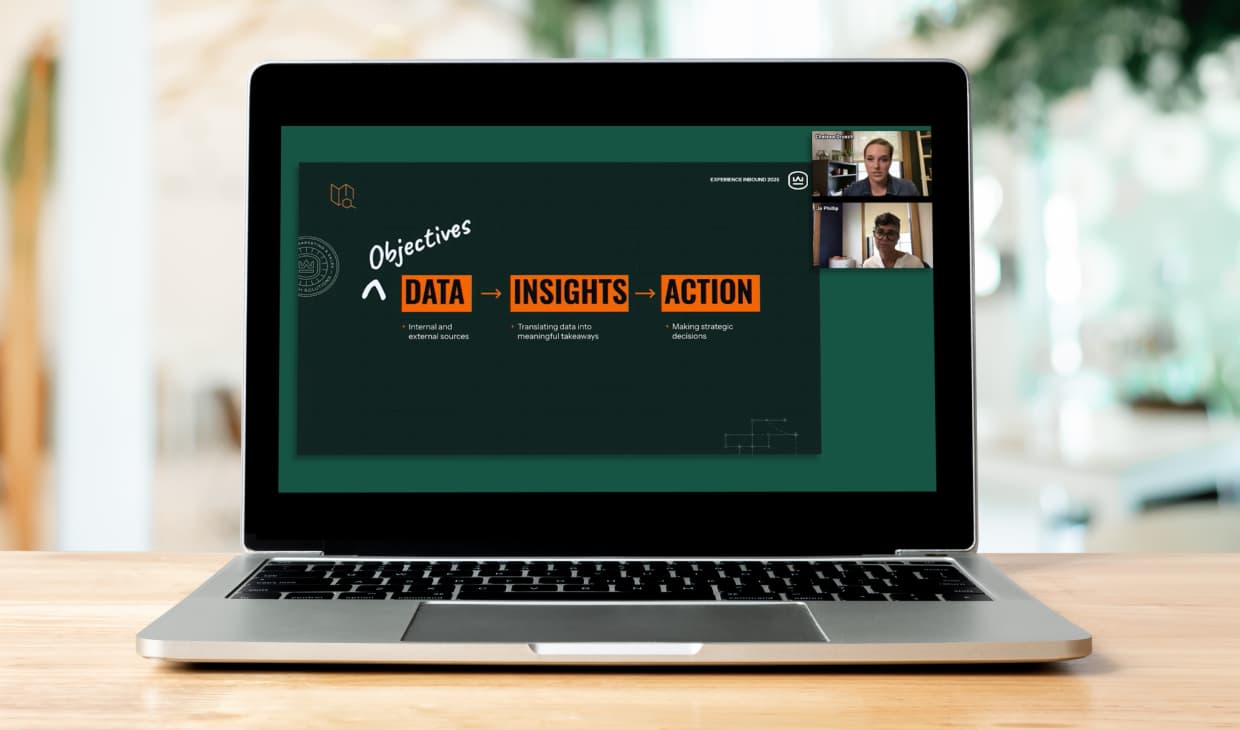Top 12 Questions About Inbound Marketing for Industrials
Written by
If you work in business development for a manufacturer or another type of industrial company, you’re no doubt at least somewhat familiar with inbound marketing. Many industrials are (finally) making the leap from traditional marketing to inbound strategies…but, like you, some still have questions. Or maybe you’ve been practicing inbound for a while now, but it seems like the definition has evolved over time (you’d be correct).
We’re breaking down 12 of the most common questions about inbound marketing in 2025 and sharing some actionable insights specifically tailored for industrial businesses like yours.
- What is inbound marketing?
- How does inbound marketing work, and why is it important today?
- Does inbound marketing work for B2B industries?
- How can manufacturers benefit from inbound marketing?
- What does it cost to get started with inbound marketing?
- Do we need a new website?
- What technology do I need to make inbound marketing work?
- How long does it take to see results with inbound?
- What resources do I need to sustain an effective inbound marketing strategy?
- How often should we publish content?
- What’s the best way to get started with inbound marketing?
- Can paid media provide a boost?
1. WHAT IS INBOUND MARKETING?
Inbound marketing is still all about meeting your prospects where they are — online. It’s a strategy that uses content, search engines, social communities, and an assortment of marketing tactics to attract your best prospects to your brand, nurture them with information they’re looking for, and convert them into qualified leads and customers.
Buyers today do their pre-purchase research online — and industrial buyers are no exception! Inbound marketing takes advantage of this behavior to enable companies to demonstrate value and alignment by delivering the right content at the right time to the right prospects.
Unlike outbound marketing, which broadcasts generalized, “one-size-fits-all” messages to the masses, inbound draws prospects in by providing answers to prospects’ specific questions and challenges.
A well-designed inbound program offers relevant content for every stage of the buyer’s journey. Here are some examples:
- Awareness stage: Blogs, videos, and micro social content that address common industry challenges
- Consideration stage: Case studies, product videos, or interactive assessments comparing different solutions
- Decision stage: Product demos or consultation offers to guide final decisions
RELATED: Catch this podcast episode all about “Brand Awareness 3.0” strategies for industrials.
2. How does inbound marketing work, and why is it important today?
Inbound marketing follows a simple (and proven) four-step methodology:
- Attract: Use content, SEO, social media, and more to build brand awareness and authority with your audience and position yourself as a trustworthy resource
- Engage: Offer resources like webinars, ebooks, white papers, or interactive assessments (sometimes that live on your website, sometimes not) that help convert your audience into leads
- Close: Use tools like email nurturing, CRM integration, and sales enablement to convert leads into customers with personalized outreach
- Delight: Keep the relationship going post-sale by offering additional resources and support to build loyalty and encourage repeat business
 This strategy is a direct response to today’s buyer behaviors. Buyers today “shop around” more independently than ever, conducting most of their research before ever reaching out to a potential vendor partner. In fact:
This strategy is a direct response to today’s buyer behaviors. Buyers today “shop around” more independently than ever, conducting most of their research before ever reaching out to a potential vendor partner. In fact:
- 70% of a buyer’s journey is now conducted online
- 81% of B2B buyers engage with 3 to 7 pieces of content before reaching out to a potential partner
- 90% of B2B buyers research between 2 and 7 different potential vendor websites before making a purchase decision
Because an inbound approach focuses on delivering useful buyer journey content, it ensures that your message is there when buyers are searching online for answers—so you’re top of mind when they’re ready to make a decision.
Google's 7-11-4 Rule is helpful for marketers and salespeople to keep in mind — it’s a bold reminder of the number of touch points it takes to actually engage prospects and turn them into customers through consistent, meaningful interactions with your brand. Google’s 7-11-4 Rule suggests that, at a minimum, it takes:
- 7 hours of exposure (engagement with your brand across various channels)
- 11 interactions with your messaging
- 4 locations (different platforms or environments)
3. Does inbound marketing work for B2B industries?
Yes – in fact, it works especially well for most B2B organizations! Most of Weidert Group’s clients sell highly considered products (those that require a lot of research, that have long sales cycles, and that represent a significant investment), and all have been successful attracting their ideal prospects and turning them into customers.
An inbound approach is ideal for complex B2Bs because your buyers rely on data, reviews, peer testimonials, case studies and other types of information to help them make their purchase decisions – and inbound puts content designed to address those specific needs right at their fingertips.
4. How can manufacturers benefit from inbound marketing?
For manufacturers, inbound marketing is a game-changer. It allows you to:
- Showcase your expertise with helpful content. That might be a video explaining how your product beats competitors’, a tip sheet on what to look for in a vendor partner, an article about the quantifiable results your product can deliver…the list goes on and on.
- Solve your prospects’ problems by providing very targeted resources. Every prospect has questions about your product’s performance relative to competitors’, or what your total cost of ownership (TCO) is, how long they can expect before a return on investment, how your product future-proofs their business…again, the list goes on and on. By answering these and other questions in your content, you demonstrate your ability to deliver value and solve problems.
- Nurture leads with a strategic approach tailored to high-ticket or complex products that require extensive research and trust-building (those that typically have a long sales cycle). That means understanding their buyer journey and the information they need to feel confident in their decision to partner with you.
5. What does it cost to get started with inbound marketing?
You won’t love this answer, but…“it depends.” It depends first on your revenue growth and long-term business goals. Then consider whether or not your website is inbound-ready, how many resources you currently have, the effectiveness of your social media presence, the internal alignment on your positioning in the market, and a number of other factors.
It depends on so many factors that we’ve developed our own Inbound Readiness Assessment to ensure we’re building the best plan to meet our prospective clients’ needs, budget, and goals.
We can, however, provide some ballpark numbers:
- Foundational setup: Typically the cost for getting a foundation set is between $25,000 and $45,000 for the first 90–180 days, covering website optimization, strategy, and keystone content. If an entirely new site is needed, the budget is higher.
- Ongoing programs: The average is between $12,000 and $20,000 monthly, depending on your scope and the speed with which you’re able to proceed
It’s an investment, yes—but one with proven ROI.
6. Do we need a new website?
Not necessarily—but your website must be “inbound-ready.” That means it’s:
- SEO-optimized: Easily discoverable for relevant search terms
- User-friendly: Simple to navigate, with a structure that guides visitors through the buyer’s journey
- Action-oriented: Includes clear calls-to-action (CTAs) to capture leads
If your current site doesn’t check these boxes, it’s probably time for an upgrade. A powerful, modern website can often be completed within 90 days.
RELATED: Learn more about our approach to website strategy, design & development here.
7. What technology do I need to make inbound marketing work?
Implementing inbound marketing typically involves adopting tools that complement and integrate with your existing systems, especially your CRM. A platform like HubSpot is not just an inbound marketing tool but also a CRM designed to create a single source of truth for all customer-facing teams. This integration ensures smoother adoption by providing value across marketing, sales, and service teams.
Here’s how integrated technology supports inbound marketing success:
- Enhances collaboration: Sales and marketing teams work from a unified platform, reducing friction.
- Boosts efficiency: Automations and integrations streamline tasks like lead management and follow-ups.
- Improves usability: Modern inbound tools focus on user-friendly interfaces, easing the learning curve for sales teams.
If your current systems lack certain capabilities, inbound tools like HubSpot are designed to integrate seamlessly, minimizing disruption. The key is to evaluate your tech stack with your teams to ensure the new tools meet their needs and align with existing workflows.
8. How long does it take to see results with inbound?
Inbound marketing isn’t instant gratification — it sounds cliché, but it truly is a marathon, not a sprint. While some gains can appear in a few months (or sooner), significant results come with a consistent, long-term approach.
How long it takes for the needle to move depends on:
- Your starting point (e.g. do you have content and and are you promoting it?)
- The resources and capabilities you commit to the strategy (it’s true that the more you put into it, the faster you’ll get results)
- The relative position of competitors in your industry (if competitors have established themselves in the market with strong content, it could take a bit longer to make inroads)
While some results may appear within months, a consistent and strategic approach ensures long-term success.
9. What resources do I need to sustain an effective inbound marketing strategy?
At a minimum, you’ll need a dedicated marketing professional with expertise in:
- Managing sophisticated tools like HubSpot
- Overseeing the creation and promotion of content
- Understanding and applying SEO principles to your website and content
- Analyzing performance and using insights to optimize tactics
- Conducting audience research and using it in your strategies and tactics
Many companies choose to partner with an experienced inbound agency rather than try to hire the right talent; this way, they have the benefit of a skilled team of experts that can execute quickly and successfully.
LEARN FROM THE EXPERTS: The ChangeOver Podcast by the Weidert team covers an array of growth-related topics that are top of mind for industrial marketers and sales pros today.
10. How often should we publish content?
The frequency of publishing content is no longer about adhering to a strict calendar or hitting a predefined number of posts per week or month. Instead, it’s about aligning your content efforts with your business goals and being responsive to your audience’s needs and market dynamics.
Here’s what matters most:
- Quality over quantity: Focus on creating high-value, relevant content that addresses your audience’s specific challenges and interests.
- Strategic alignment: Let your business objectives guide your content. For example, if you’re targeting a new market, prioritize creating resources that speak to their unique needs.
- Agility and responsiveness: Monitor performance, listen to customer feedback, and adapt your content strategy as conditions change.
Publishing consistently is still important to maintain visibility and relevance, but it’s more effective to think of your content as part of a broader, integrated campaign. A “hero” asset — like a whitepaper, video, or case study — should be supported with related outreach such as social media posts, email campaigns, and website updates. This ensures your efforts are coordinated and impactful.
RELATED: Watch this episode of The ChangeOver podcast where our two content strategy gurus, Chelsea and Jo, pull back the curtain on future-proofing your content strategy in an AI-driven world.
11. What’s the best way to get started with inbound marketing?
Getting started with inbound marketing is pretty straightforward, though of course each step requires a fair amount of learning in order to do it well (that’s why many organizations choose to partner with inbound experts). Here’s a general roadmap:
- Identify realistic goals for inbound. The first question is how many leads do you need to reach the number of closed customers you need to reach your revenue goals?
- Invest in the necessary tools and platforms that match your needs. HubSpot is an “all-in-one” platform from which you can execute comprehensive Marketing activities (manage campaigns, create and post content, monitor metrics, perform SEO, create landing pages, send automated emails, manage paid ads… and more) as well as manage Sales and Customer Service activities, and your website. There are a ton of efficiencies to be gained by using a single system!
- Create content. Use audience research (tools and real-life input from your teams) to address common buyer challenges
- Promote and analyze. Use paid ads and analytics to refine your strategy.
- Consider partnering with an experienced inbound agency to fast-track your success
LEARN MORE: 7 Steps to Start a Complete & Powerful Inbound Marketing Program
12. can paid media provide a boost?
While once thought of as a strictly outbound tactic, pay-per-click (PPC) ads can fuel even faster inbound program results by:
- Driving targeted traffic to your website
- Testing the effectiveness of the content you’re publishing
- Supporting campaigns like product launches or event promotions
The key is to keep a helpful mindset at all times — matching your ad keywords to the intent of the searcher, and ensuring your content aligns with that intent. Otherwise you'll just be throwing money at unqualified clicks.
GET STARTED
Not that long ago, inbound marketing was sometimes viewed as a fad. But after a decade of unmitigated success in industries from one end of the spectrum to another, it’s now “marketing how it has to be done today.” It’s the most effective way for industrial businesses to attract the right prospects, build trust, and drive revenue — because it matches the way your buyers behave and the experiences they’ve come to expect.
If you’re ready to take the leap, we’d love to help. Let’s chat about how we can grow your business together.
Subscribe To Our Blog
Information. Insights. Ideas. Get notified every time a new Weidert Group blog article is published – subscribe now!
You May Also Like...

Podcast
AI + Audience Research: The New Formula for Marketing Advantage

Content Marketing
Resonance Over Reach: A Thought Leadership Guide for B2Bs

Search Engine Optimization
AI Search: The Missing Link in Your Manufacturing Sales Pipeline | Weidert News
Accelerate Your Growth with
Weidert Group
If you’re ready to explore a partnership, request a personalized consultation with our team.

